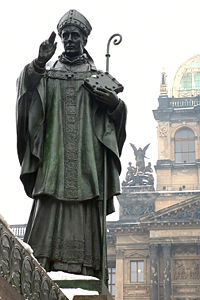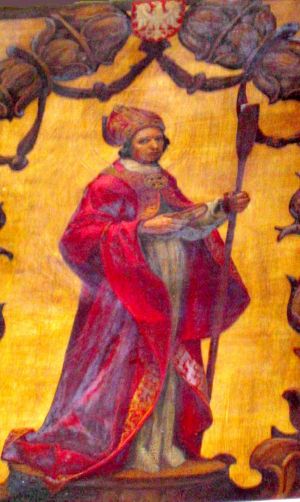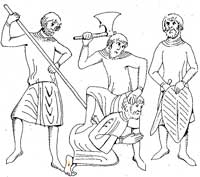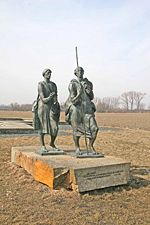Difference between revisions of "Saint Adalbert" - New World Encyclopedia
Chris Jensen (talk | contribs) |
Chris Jensen (talk | contribs) |
||
| Line 32: | Line 32: | ||
== Biography == | == Biography == | ||
===Early Life=== | ===Early Life=== | ||
| − | Vojtěch was born into the noble family of Prince Slavnik and his wife Střezislava in Libice nad Cidlinou, Bohemia | + | Vojtěch was born into the noble family of Prince Slavnik and his wife Střezislava in Libice nad Cidlinou, Bohemia. Vojtěch had five full brothers: Soběbor (Slavnik's heir), Spytimir, Pobraslav, Porej, Caslav and a half-brother Radzim Gaudenty (from his father's liaison with another woman). As was common at the time, Radzim and Vojtěch, two of these upper-class youths, were groomed for ecclesiastical careers.<ref>The phenomenon of courtier-bishops is discussed at length in Jaeger's article, with specific mention of Adalbert on p. 300 (ff. 26).</ref> Of the two, Vojtěch was an exceptionally well-educated man, having studied for about ten years (970-80) in Magdeburg under Saint [[Adalbert of Magdeburg|Adalbert]], who so impressed his young pupil that he chose to take his mentor's name at his confirmation. Gifted and industrious, though lacking in an overarching goal or vision, Adalbert Vojtěch completed his studies and took up the carefree life of a man of arms (ca. 980).<ref>Baring-Gould, 311; Farmer, 3. A more complete account of his illustrious family's history can be found in the ''Chronica Boëmorum'', accessible online (in the original Latin) at [http://mdz10.bib-bvb.de/~db/bsb00000683/images/index.html?seite=2 Monumenta Germaniae Historica].</ref> |
===Religious Career=== | ===Religious Career=== | ||
Revision as of 22:59, 21 September 2007
| Saint Adalbert of Prague | |
|---|---|
| Apostle of Prussia | |
| Born | c. 956 in Libice nad Cidlinou, Bohemia |
| Died | 997 in Truso (Elbląg) or Kaliningrad Oblast |
| Venerated in | Roman Catholic Church |
| Canonized | 999
by Pope Sylvester II |
| Major shrine | Gniezno, Prague |
| Feast | April 23 |
| Patronage | Bohemia; Poland; Prussia |
Adalbert (born Vojtěch; c. 956–April 23, 997) was a high-born Czech who served his faith as a bishop of Prague and a Benedictine monk. In spite of his efforts, he was martyred during his mission to convert the Baltic Prussians—a mission that had been instigated by the king of Poland Bolesław I the Brave. For his service to the Catholic Church, he was was posthumously honored as the patron saint of Bohemia, Poland, Hungary, and Prussia. His feast day is celebrated on April 23.
Biography
Early Life
Vojtěch was born into the noble family of Prince Slavnik and his wife Střezislava in Libice nad Cidlinou, Bohemia. Vojtěch had five full brothers: Soběbor (Slavnik's heir), Spytimir, Pobraslav, Porej, Caslav and a half-brother Radzim Gaudenty (from his father's liaison with another woman). As was common at the time, Radzim and Vojtěch, two of these upper-class youths, were groomed for ecclesiastical careers.[1] Of the two, Vojtěch was an exceptionally well-educated man, having studied for about ten years (970-80) in Magdeburg under Saint Adalbert, who so impressed his young pupil that he chose to take his mentor's name at his confirmation. Gifted and industrious, though lacking in an overarching goal or vision, Adalbert Vojtěch completed his studies and took up the carefree life of a man of arms (ca. 980).[2]
Religious Career
In 980, Adalbert finished his studies at Magdeburg school and returned to Prague where he became a priest. In 981 his father, Prince Slavnik, and both his mentors died.
In 982, still not yet thirty years old, Adalbert became the Bishop of Prague. However, he strongly resented the participation of formally Christian inhabitants in the slave trade. Although Adalbert descended from a rich family and could afford comfort and luxury, he lived poorly of his own free will. He was noted for charity, austerity, and zealous service to the Church. His duty was difficult even in baptized Bohemia, as the pagan creed was deeply embedded in the peoples' minds. Adalbert complained of polygamy and idolatry, which still were not unusual among the Czechs.
In 989 he resigned from his bishop's cloth and left Prague. He went to Rome and lived as a hermit in St. Alexis Benedictine monastery.
Four years later, in 993, Pope John XV sent him back to Bohemia. Adalbert became the Bishop again. That time he founded a monastery in Břevnov, near Prague, the first one for men in the Czech lands. However, he continued to meet with the same kind of opposition to his ministry from the nobility that he had faced earlier. Also, according to Cosmas' chronicle, high clerical office was a burden to Adalbert, and in 994 he offered it to Strachkvas who was Přemyslid and Duke Boleslav's brother. Strachkvas, nevertheless, refused.
In 995 Slavniks' former rivalry with the Přemyslids resulted in the storming of Libice and a cruel murder of four (or five) of Adalbert's brothers. All this was done by the will of Boleslav II of Bohemia, and the key executioners were his confederates from a powerful clan of Vršovci. Thus the Zličan princedom became part of the Přemyslids' estate.
Adalbert damned the Vrśovci in church and predicted that they would be severely persecuted. After the tragedy he could not stay in Bohemia and escaped from Prague, despite the Pope's call for him to return to his episcopal see. Strachkvas was eventually appointed to be his successor. However, when he was going to assume the Bishop office in Prague, he suddenly died during the ceremony itself. Circumstances of his death are still unclear.
As for Adalbert, he went to Hungary and baptized Géza of Hungary and his son Stephen in the city of Esztergom. Then he went to Poland where he was cordially welcomed by Bolesław I the Brave. After the short visit Adalbert went to Prussia with a Christian mission.
Mission and Martyrdom in Prussia
Adalbert Vojtěch of Prague had already in 977 entertained the idea of becoming a missionary in Prussia. After he had converted Hungary, he was sent by the Pope to convert the heathen Prussians. Boleslaus the Brave, duke of Poland (later king), sent soldiers with Adalbert. The bishop and his followers - including his half-brother Radzim (Gaudentius) - entered Prussian territory near Gdańsk and went along the Baltic Sea coast.
It was a standard procedure of Christian missionaries to try to chop down sacred oak trees (see Iconoclasm), which they had done in many other places, including Saxony. Because the trees were worshipped and the spirits who were believed to inhabit the trees were feared for their powers, this was done to demonstrate to the non-Christians that no supernatural powers protected the trees from the Christians.
When they did not heed warnings to stay away from the sacred oak groves, Adalbert was executed for sacrilege, which his co-religionists interpreted as martyrdom, in April 997 on the Baltic Sea coast east of Truso (currently Elbląg) near Tenkitten and Fischhausen (see external link map St. Albrecht) It is recorded that his body was bought back for its weight in gold by Boleslaus the Brave.
Canonization and Legacy
A few years later Adalbert was canonized as Saint Adalbert of Prague. His life has been written about in Vita Sancti Adalberti by various writers, the earliest being traced to imperial Aachen and Liège, although it was assumed for many years that the Roman monk John Canaparius wrote the first Vita in 999. Another famous biographer of Adalbert was Saint Bruno of Querfurt who wrote his hagiography in 1001-1004.
Notably, Bohemian rulers (i.e., Přemyslids) initially refused to ransom Saint Adalbert's body from the Prussians who murdered him, so it was purchased by Poles. This fact may be explained by Saint Adalbert's belonging to the Slavniks family; it highlights the strength of the two clans' conflict. Thus Saint Adalbert's bones were stored in Gniezno and helped Boleslaus the Brave to improve Poland's position in Europe.
It is said that in 1039 the Bohemian duke Bretislav I retrieved the bones of Saint Adalbert from Gniezno and moved them to Prague. According to another version, he took only part of the bones, while the rest of Saint Adalbert's relics (including the skull) were hidden by the Poles (according to Roczniki Polskie) and found in 1127. In 1928, one of the arms of Saint Adlbert, which Bolesław I had given to Otto III in the year 1000, was added to the bones preserved in Gniezno. Today Saint Adalbert has two graves, and which bones are authentic is still not clear. For example, the saint has two skulls - one in Prague, a second in Gniezno (stolen in 1923).
June 1997 was the thousandth anniversary of Saint Adalbert's martyrdom. It was commemorated in the Czech Republic, Poland, Germany, Russia and other countries. Representatives of Catholic, Greek Orthodox, and Evangelical churches pilgrimaged to Gniezno, to the saint's tomb. John Paul II visited Gniezno and held a ceremonial divine service in which heads of seven European states and about a million believers took part. In Kaliningrad Oblast, near Beregovoe village (former Tenkitten), where Adalbert's death hypothetically took place, a ten-meter cross was established.
Notes
- ↑ The phenomenon of courtier-bishops is discussed at length in Jaeger's article, with specific mention of Adalbert on p. 300 (ff. 26).
- ↑ Baring-Gould, 311; Farmer, 3. A more complete account of his illustrious family's history can be found in the Chronica Boëmorum, accessible online (in the original Latin) at Monumenta Germaniae Historica.
ReferencesISBN links support NWE through referral fees
- Attwater, Donald and Catherine Rachel John. The Penguin Dictionary of Saints. 3rd edition. New York: Penguin Books, 1993. ISBN 0-140-51312-4.
- Baring-Gould, S. (Sabine). The Lives of the Saints. With introduction and additional Lives of English martyrs, Cornish, Scottish, and Welsh saints, and a full index to the entire work. Edinburgh: J. Grant, 1914.
- Butler, Alban. Lives of the Saints. Edited, revised, and supplemented by Herbert Thurston and Donald Attwater. Palm Publishers, 1956.
- Campbell, T. J. "Saint Adalbert" in The Catholic Encyclopedia. 1909.
- Farmer, David Hugh. The Oxford Dictionary of Saints. Oxford; New York: Oxford University Press, 1997. ISBN 0192800582.
External links
- Map of Prussia from c 1660 with St. Albrecht location between Tenkitten and Fischhausen, west of Königsberg.
Credits
New World Encyclopedia writers and editors rewrote and completed the Wikipedia article in accordance with New World Encyclopedia standards. This article abides by terms of the Creative Commons CC-by-sa 3.0 License (CC-by-sa), which may be used and disseminated with proper attribution. Credit is due under the terms of this license that can reference both the New World Encyclopedia contributors and the selfless volunteer contributors of the Wikimedia Foundation. To cite this article click here for a list of acceptable citing formats.The history of earlier contributions by wikipedians is accessible to researchers here:
The history of this article since it was imported to New World Encyclopedia:
Note: Some restrictions may apply to use of individual images which are separately licensed.



